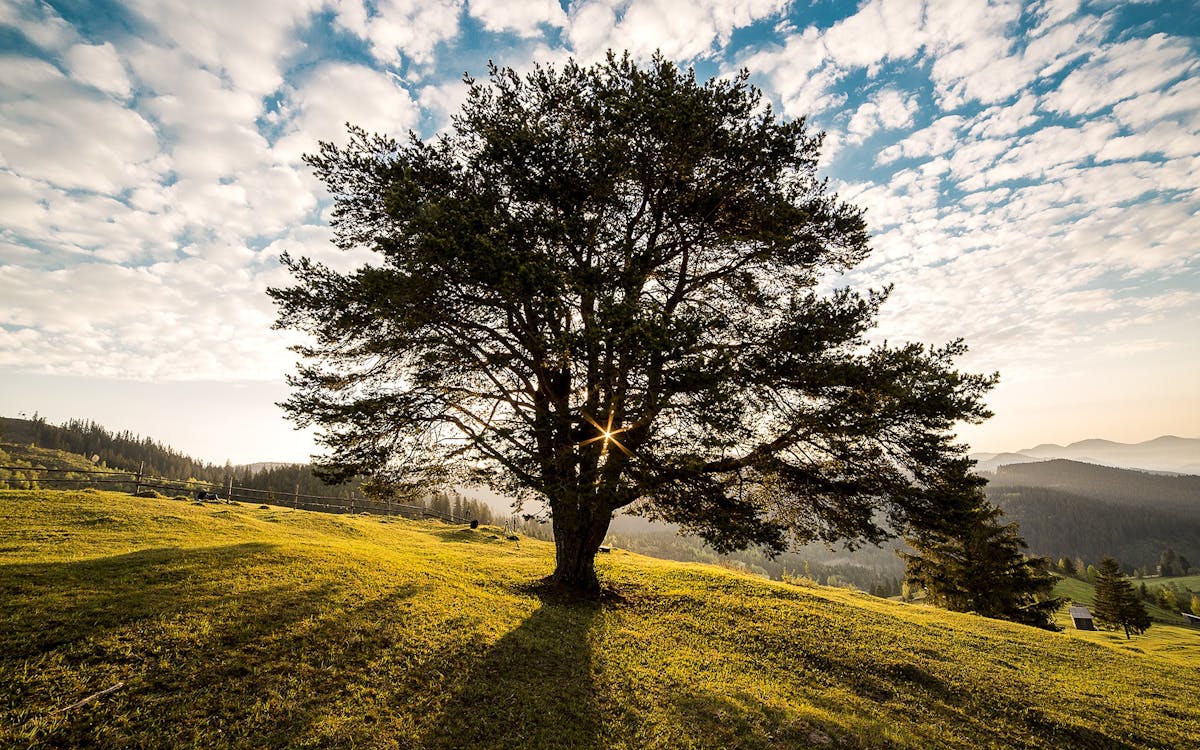Trees are essential to our environment and have many significant impacts on the planet. Trees help to reduce air pollution and store carbon dioxide, providing a natural defence against climate change. They also provide crucial habitats for birds, insects, and other wildlife. Trees absorb rainwater, reducing soil erosion and helping to prevent flooding in rivers and streams.

Furthermore, trees cool down urban areas by providing shade, improving air quality through photosynthesis, and releasing oxygen into the atmosphere. In addition to their environmental benefits, trees can be aesthetically pleasing as well as beneficial for mental health – studies show that people who live near green spaces experience an increase in well-being.
Finally, they provide food sources like nuts or fruit which can be used by humans and animals alike. All of these benefits demonstrate why trees are so important and why we should take care to protect them.
Maintaining a tree and enjoying its development into a mature specimen is a satisfying activity. If you want your tree to have deep roots and a lush, green canopy, the first few years are crucial.
Care for your tree the right way with these quick and easy instructions:
How Do You Take Care Of A Tree?
There are several steps you can take to care for a tree and help it grow healthy and strong:
1. Water The Tree Regularly:
One of the most crucial parts of tree maintenance is giving the tree plenty of water regularly. If trees don’t get enough water, they might become stunted in their growth and ultimately die. To properly water a tree, remember these guidelines:
Water The Tree Deeply:
Provide the tree with a thorough soaking; plants of any kind should not be satisfied with surface soaking. Make sure to water the tree well, all the way down to the root system (the area where the roots are located). As a general rule of thumb, you should water your tree with around 10 gallons for every inch of its trunk diameter.
Water The Tree Consistently:
It’s crucial to maintain a regular schedule when watering trees. If you can, try to water the tree at the same time each day or week.
Water The Tree During Dry Spells Or Drought Conditions:
Trees are especially susceptible to drought stress during dry spells and drought conditions, thus it’s important to water them then. Keep the tree well-watered so that it can survive these periods.
Avoid Over-Watering The Tree:
Even though it’s vital to water the tree regularly, it’s equally important to avoid drowning it. Root rot, caused by overwatering, can kill a tree.
If you follow these guidelines, you should be able to provide your tree with the care it needs to flourish.
2. Fertilize The Tree:
Fertilizing a tree ensures that it receives the nutrients it needs to thrive. Nitrate, phosphate, and potassium are just a few of the many nutrients trees require for optimal growth. The application of a tree-specific fertilizer can aid in this regard by furnishing the necessary nutrients for a robust expansion.
Some suggestions on how to fertilize a tree:
Pick The Proper Fertilizer:
Get a tree-friendly fertilizer. Try to find a fertilizer with an even breakdown of elements, like a 20-20-20 or 10-10-10 composition.
Follow The Manufacturer’s Instructions:
Be sure to apply the fertilizer according to the directions provided by the manufacturer. This will help you apply the fertilizer at the optimal time and in the appropriate amount.
Use Fertilizer At The Proper Time:
Fertilizing trees is best done at different times of the year depending on the tree species and local temperature. Generally speaking, fertilizing a tree in the fall or early spring, when it is dormant, is optimal.
Avoid Over-Fertilizing The Tree:
Overfertilizing a tree can cause it to grow too quickly and could even be hazardous to the tree in the long run, so it’s best to refrain from doing so. Fertilizer should be applied according to the manufacturer’s instructions.
With these guidelines in mind, you may give your tree a better chance of getting the nourishment it needs to flourish. If you’re not sure how much fertilizer to give your tree, or if you have any other issues, consulting an arborist is a good option.
3. Prune The Tree:
To prune is to remove branches that are diseased, broken, or otherwise no longer useful to the tree. It can sculpt the tree while encouraging healthy growth. If you’re interested in learning how to prune a tree, consider the following advice:
Obtain The Appropriate Equipment:
Invest in high-quality equipment before you begin trimming. Smaller branches can be pruned using hand pruners, while bigger branches should be cut with loppers or pruning saws.
Make Clean, Smooth Cuts:
Make precise, even cut with a sharp instrument. Damage to the tree can be caused by ripping or making cuts that are too sharp.
Prune At The Right Time:
The optimal time of year to prune a tree varies depending on the tree species and the local climate. Most trees benefit from being pruned when they are not actively developing, which is often between the late fall and early spring.
Remove Dead Or Damaged Branches:
Discard any broken or decaying branches. These limbs pose a health risk if they fall and expose people to whatever insects or diseases they may be carrying.
Prune For Shape:
Shape the tree by removing branches as needed to promote strong, healthy development. Trees might suffer stress if more than 25% of their canopy is cut away in a single growing season.
If you follow these guidelines, your tree has a better chance of flourishing. If you’re not sure how to prune your tree, it’s smart to consult an expert.
4. Protect The Tree From Pests:
It is crucial to keep pests away from a tree when caring for it. Unchecked, pests like insects and diseases can severely damage or even kill a tree. You can take the following measures to keep pests away from your tree:
Keep An Eye Out For Pests:
Pests can cause damage to your tree, so keep an eye out for things like holes in the leaves or branches and unusual growth patterns as warning indications.
Identify The Pest:
If you find pests on your tree, it’s important to figure out what kind they are. You can use this to figure out what steps are most beneficial.
Use Natural Pest Control Methods:
You may protect your tree from pests without resorting to harmful chemicals by using natural pest management measures. Some of these methods include employing natural insect repellents like neem oil or garlic spray or reintroducing natural predators like birds or bats to the region.
Use Chemical Pest Control Products:
If natural insect prevention measures fail, chemical pest control treatments can be used to keep harm at bay. Before using any chemical product, make sure you read the label and follow the directions provided by the manufacturer.
If you follow these instructions, you should be able to keep your tree free of harmful pests for a long time. If you have any questions or worries regarding how to keep pests away from your tree, it’s best to see a professional arborist.
5. Mulch Around The Tree:
Mulching the ground close to a tree can improve its health in several ways. Mulch is a material applied around a tree’s trunk and roots to keep the soil moist and prevent weeds. Some advantages of using mulch around a tree include:
Retains Moisture In The soil
Mulch is useful because it keeps the soil moist, which is good for the trees. You may need to water the soil less often if you use this technique.
Suppresses Weeds:
Mulch helps prevent weeds, which would otherwise choke the tree out of its water and nutrient supply, from germinating and growing. Mulch applied around a tree’s trunk can help keep weeds from taking root and starving the tree of water and nutrients.
Protects The Tree:
Mulch can help shield a tree from any harm caused by lawn equipment like mowers and weed whackers. It can also shield the tree from the damaging effects of rapid temperature changes.
Improves The Appearance Of The Tree:
Giving the tree a completed, well-maintained look, mulch is another way to boost its curb appeal.
Mulch should be applied around a tree in a thin layer (two to three inches) and kept a few inches away from the trunk and roots. This will keep the mulch from suffocating the tree and ensure that it receives enough oxygen. Choose a mulch that has been developed for trees; this will increase the likelihood that it will deliver the aforementioned advantages.
6. Protect The Tree From Physical Damage:
To preserve a tree’s continued good health and robust growth, it is essential to shield it from any potential physical harm. Several different types of physical stress can harm trees. These include vehicles, construction, and severe weather. The following are some preventative measures you may take to ensure your tree avoids any physical harm:
Keep Cars And Other Vehicles Away From The Tree:
To protect the tree’s trunk and roots, please park your car or another vehicle safely away from the tree.
Protect The Tree From Construction:
If you are planning a building project near the tree, you need to take precautions to ensure that the tree is not damaged. There are a few different ways to go about this, the most common being the installation of protective fencing around the tree or the engagement of a tree protection expert to manage the project.
Protect The Tree From Extreme Weather:
Storms and high winds, for example, can cause significant damage to trees, so it’s important to keep them safe. Staking the tree or putting up lightning rods are both good options if you reside in a region prone to severe weather.
Keep your tree healthy and safe from harm by following these instructions. If you have any questions or worries about how to best preserve your tree, consulting a certified arborist is another good choice.
Conclusion
Taking care of trees is essential for our environment and our well-being. Planting more trees can help to improve local air quality, provide habitats for wildlife, reduce soil erosions, buffer noise pollution, and even increase property values in urban areas.
Taking measures to protect existing trees is also important to ensure that these benefits are maintained. As we become increasingly aware of the importance of environmental protection, it is clear that trees play an important role in preserving our planet’s health as well as improving our daily lives.
By following the guidelines outlined above, you can ensure that your tree receives the care it needs to remain healthy and beautiful. With a little effort, you can create a lush landscape that will thrive for years to come. Tree care is an important part of responsible landscaping, so be sure to take the time to give your tree the attention it deserves!
If you have any questions about tree care, don’t hesitate to consult a professional arborist or other experts for advice. With their help, you can ensure that your tree remains healthy and strong for many years to come.
https://www.youtube.com/watch?v=WM7KHOJOtRI&pp=ygUfSG93IERvIFlvdSBUYWtlIENhcmUgT2YgQSBUcmVlPw%3D%3D
